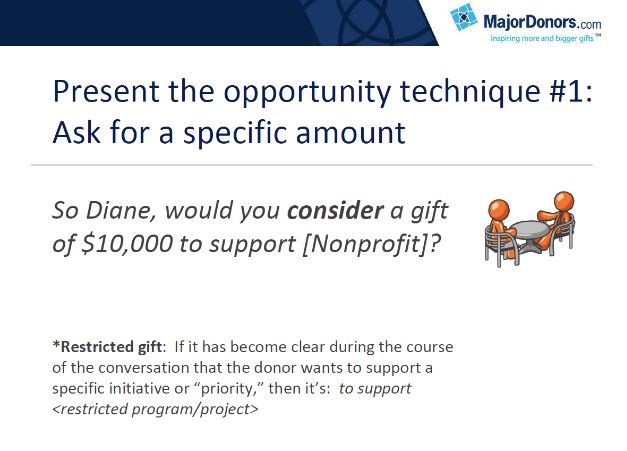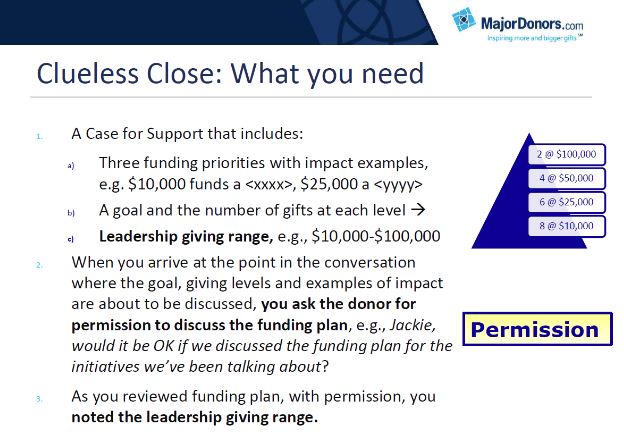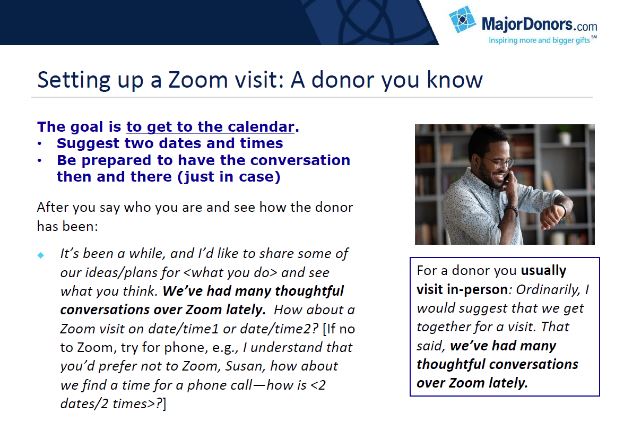Cultivating a major donor and setting the stage to make an ask for money doesn’t have to be a nerve-wracking experience. For context, when we talk about major donors, we’re referring to donors who make a significant gift to your org – one that’s above and beyond the typical gift that arrives in the mail. Usually, $10,000 is a common benchmark (but splitting that into two payments of $5,000 over two years could still be considered a major gift.)
Donor money can be categorized in two ways: restricted or unrestricted. Restricted gifts are earmarked for a specific purpose or project. Unrestricted gifts, on the other hand, have no strings attached and can be used for any purpose.
Diane Remin, President of MajorDonors.com
We sat down with Diane Remin, the Founder and President of MajorDonors.com, to discuss techniques on making an ask and how major gift work has transitioned online as a result of the pandemic. Diane was named a top-25 fundraising consultant by Philanthropy Media in 2016. She has served on the boards of The Food Project, Fuller Craft Museum, and Cambridge Family & Children’s Service. She is also a member of the Association of Fundraising Professionals (AFP) and the Planned Giving Group of New England.
Watch the webinar on-demand here. Below are some of our major takeaways from the conversation!
Technique 1: Ask Donor For A Specific Amount of Money
Dialing down to a specific amount is one of the most widely used, tried-and-true fundraising techniques. This technique is appropriate for donors who have a track record of giving to your organization or when you want to make a multi-year ask.

When making your ask, be precise, respectful, and keep your language easy for the donor to digest. Try using the following format: “So Diane, would you consider a gift of $10,000 to support [Nonprofit or restricted project]?”
For multi-year gifts, there is a slight variation in format – specify the annual amount, the number of years, and the total amount. For example, “So Diane, would you consider a gift of $15,000 per year for three years for a total of $45,000 to support [Nonprofit or restricted project]?”
Once you present the opportunity, remain silent. Don’t speak until the donor says something first. If you’re wondering why remaining silent is the best move, it’s because you want to give the person space to consider your request. Speaking creates a distraction and you’ll end up negotiating against yourself. Instead, embrace the silence and use this time to observe the donor’s core reaction.
Technique 2: The Clueless Close
The second technique is the clueless close. The clueless close is great for situations where you don’t know the donor well or if you’re uncertain on how much to ask.

There are three parts to the clueless close but before you get there, you need to have a case for support that includes:
- Three funding priorities with impact examples (e.g. $10,000 funds a [x], $25,000 funds [y], and $30,000 funds [z])
- A goal and donation tiers that specify the number of gifts at each level
- A leadership giving range (e.g. $10,000-$100,000)
After you’ve taken care of your case for support, use the following steps to make the clueless close:
1. Authentically acknowledge the relationship and situation:
“I realize that you’re just learning about our plans, [first name], but given your interest in [nonprofit/project/community], I don’t know exactly where to go from here other than wanting to be sure you have the opportunity to make the kind of difference we’ve been talking about.”
2. Restate the funding priorities, donation tiers, or leadership giving range:
“As we’ve discussed, our leadership giving ranges from $10,000 to $100,000.”
3. Make the ask:
“So, tell me, [first name], where do you see yourself?”
Similar to the first technique, don’t try and fill space after you make your ask. Stay quiet and let the donor respond first!
Pro Tip: When you arrive at the point in the conversation where the goal, giving levels, and impact are about to be discussed, ask the donor for permission to discuss the funding plan. For instance, “Jackie, would it be OK if we discussed the funding plan for the initiatives we’ve been talking about?”
Responding to “Let Me Think About It”
The likelihood that your donor will say “yes” on the spot is slim. In fact, the vast majority of the time, they won’t. Take this opportunity to learn a little more about where the donor is at.
You’ll want to confirm the donor’s interest in your cause or project and then see if a change in timing helps (e.g. “I understand you want to think about it. Is there anything we can do with the timing to make this possible for you?”).
Alternatively, if there’s another person (like a spouse) that needs to be in on the conversation, offer to involve them. Set a time to speak in the near future that includes both decision makers.
Negotiating
Unless you hear a definitive “no way” or “can’t possibly afford that”, don’t mistake initial reactions to your ask as invitations to negotiate. When you do hear a hard “no”, that’s when the following negotiation tactics come into play:
- Inquire and see if there is a timing solution
- If timing isn’t the case, re-ask at 50% of the original amount
- If you’re still stuck at “no”, ask the donor what amount of money would be possible for them now
Unless You Are At “Yes”, Set A Follow-Up Date
If your donor wants time to consider the opportunity, set a follow-up date. Otherwise, you’ll find yourself chasing after the donor – even if the donor wants to give. When setting a follow-up, offer to do what you did initially. If you met in-person, offer to return in-person; if you were on Zoom, offer to set up another Zoom call. Let your donor know that you’ll be available to answer any questions they may have.
If your donor declines, try setting up a phone call instead. We recommend offering two date/time options, two weeks out.
Asking a Donor for Money Via Zoom
It’s totally possible to have thoughtful conversations over Zoom and the techniques detailed above are interchangeable whether you’re asking in-person or online.

The goal for a Zoom meeting is simply to get it on the calendar. For context, most in-person donor visits run 40-60 minutes. On Zoom, a typical donor visit will run 30-45 minutes. We recommend providing your donor with two date/time options. If you’re unsure how long a Zoom visit should be or if your donor asks, 30 minutes should be sufficient.
Get Started On Your Next Major Ask With CauseVox
To learn more about how CauseVox CRM can help you track and manage donors so that you can build relationships that last, schedule a demo.
Editor's Picks
Ultimate Guide To Peer-to-Peer Fundraising
Customer Story: Spur Local Raises Over $1M With Their Give Local Campaign
Fundraising Strategies for Nonprofits: Craft the Best Approach for Your Organization
Create a Killer Fundraising Plan - Best Practices, Strategies, & Downloadable Template



